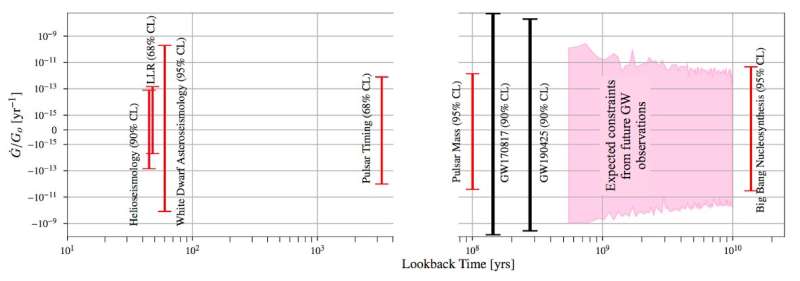May 4, 2021 feature
Study places new constraints on the time variation of gravitational constant G

Past physics theories introduced several fundamental constants, including Newton's constant G, which quantifies the strength of the gravitational interaction between two massive objects. Combined, these fundamental constants allow physicists to describe the universe in ways that are straightforward and easier to understand.
In the past, some researchers wondered whether the value of fundamental constants changed over cosmic time. Moreover, some alternative theories of gravity (i.e., adaptations or substitutes of Einstein's theory of general relativity), predict that the constant G varies in time.
Researchers at the International Centre for Theoretical Sciences of the Tata Institute for Fundamental Research in India recently proposed a method that can be used to place constraints on the variation of G over cosmic time. This method, outlined in a paper published in Physical Review Letters, is based on observations of merging binary neutron stars.
"Several experiments have constrained the amount of variation of G," Parameswaran Ajith, one of the researchers who carried out the study, told Phys.org. "Our work shows that gravitational wave observations of neutron star binaries provide a new method for measuring the time variation of G. From the gravitational wave signal arising from a binary neutron star merger, we can measure the combination GM /c2, where M is the total mass of the binary and c is the speed of light. If we have an independent measurement of M and c, we can determine the value of G."
While the speed of light is known, there is no independent measurement of a binary star merger's mass. What is known, however, is that neutron stars have specific mass limits.
Specifically, physicists know that if a neutron star is too massive, it will collapse under its own gravity. On the other hand, if it is too light, it won't be able to hold on to its material. Ajith and his colleagues essentially proposed using these known mass limits to constrain the range of values that G can have during a binary star merger.
"The original idea of my collaborator Shasvath Kapadia was to use the electromagnetic emission from the merger to independently estimate the mass of the binary," Ajith said. "While this is, in principle, possible, the uncertainties in this measurement are large due to the complex physics involved. In the future, such a measurement might also be possible."
The findings gathered by Ajith and his colleagues introduce new constraints on the gravitational constant (G) over a cosmological epoch that is not probed by any other observations. In fact, past observations generally probe the very early universe (i.e., minutes after the Big Bang) or the most 'recent' version of the universe (i.e., up to approximately 100 million years ago).
The method developed by this team of researchers could help to better understand the extent to which the gravitational constant G varies over cosmic time. Moreover, when applied to future gravitational wave observations, it could potentially allow physicists to probe the value of G for an extended cosmological epoch, spanning across 10 billion years.
"Gravitational-wave observatories like LIGO and Virgo continue to improve their sensitivities. New detectors are being built in Japan and India," Ajith said. "In the next decade, we will detect gravitational waves from hundreds of binary neutron stars. The next planned generation of detectors will detect millions of them, and each observation will constrain the value of G from a different cosmological epoch. In this way, we should be able to create a 'map' of the variation of G over an extended cosmological epoch spanning 10 billion years!"
More information: Constraints on the time variation of the gravitational constant using gravitational wave observations of binary neutron stars. Physical Review Letters(2021). DOI: 10.1103/PhysRevLett.126.141104.
Journal information: Physical Review Letters
© 2021 Science X Network




















